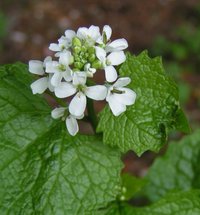Garlic Mustard
|
|
| Garlic mustard | ||||||||||||||
|---|---|---|---|---|---|---|---|---|---|---|---|---|---|---|
 | ||||||||||||||
| Scientific classification | ||||||||||||||
| ||||||||||||||
| Binomial name | ||||||||||||||
| Alliaria petiolata |
Garlic mustard (Alliaria petiolata) is a cool season biennial herb native to Europe and in the mustard family (Brassicaceae) with stalked, triangular to heart-shaped, coarsely toothed leaves that give off an odor of garlic when crushed. First-year plants appear as a rosette of green leaves close to the ground. Rosettes remain green through the winter and develop into mature flowering plants the following spring. Flowering plants of garlic mustard reach from 2 to 3-1/2 feet in height and produce buttonlike clusters of small white flowers, each with four petals in the shape of a cross. In rural Britain the plant is commonly known as Jack-by-the-hedge as it often occurs along the margins of hedgerows.
After spending the first half of its two-year life cycle as a rosette of leaves, garlic mustard plants develop rapidly the following spring into mature plants that flower. In the mid-Atlantic Coastal Plain region of the United States, seeds are produced in erect, slender, four-sided pods, called siliques, beginning in May. Siliques become tan and papery as they mature and contain shiny black seeds in a row. By late June, most of the leaves have faded away and garlic mustard plants can be recognized only by the dead and dying stalks of dry, pale brown seedpods that may remain and hold viable seed throughout the summer.
A single plant can produce thousands of seeds, which scatter as much as several meters from the parent plant. Depending upon conditions, garlic mustard flowers either self-fertilize or are cross-pollinated by a variety of insects. Self-fertilized seed is genetically identical to the parent plant, enhancing its ability to colonize an area. Although water may transport seeds of garlic mustard, they do not float well and are probably not carried far by wind. Long distance dispersal is most likely aided by human activities and wildlife. Additionally, because white-tailed deers prefer native plants to garlic mustard, large deer populations may help to expand it by removing competing native plants and exposing the soil and seedbed through trampling. The species is used as a food plant by the larvae of some Lepidoptera species including Garden Carpet. The leaves are also edible as food food for humans, and are best when young.
Garlic mustard was introduced in North America in the 1850s and is considered an invasive species there. In Europe as many as 69 varieties of insects and 7 varieties of fungi keep Garlic Mustard populations in check. Those are not present in North America, so the high seed productivity of the Garlic Mustard allows it to out-compete native plants. [1] (http://www.michigannature.org/garlicmustard.shtml)
External link
- U.S. NPS guide (http://www.nps.gov/plants/alien/fact/alpe1.htm)
- Garlic mustard recipes (http://www.patapscoheritagegreenway.org/garlic5/recipes.htm)
de:Knoblauchsrauke eo:Ajla Mustardo fr:Alliaire officinale nl:Look_zonder_look

